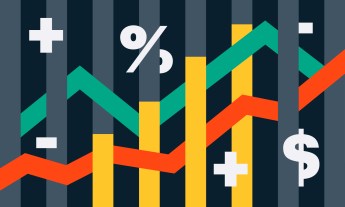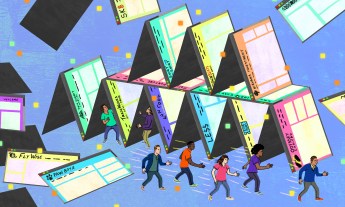Forecasting the stock market has a storied past of unfruitful predictions. But in this TED Talk, Didier Sornette shares how he and his research team have successfully identified unstable market bubbles and even predicted when they’ll pop. His findings, if accepted, could quite literally change the way we do business, by shifting how banks, traders and governments respond to apparent growth in individual markets.
In the talk, he hints at some of his most recent analysis: On May 17, 2013, he says, “we identified that the US stock market was on an unsustainable path, and we released on our website … that on the 21st of May, that there will be a change of course. And the next day, the market started to change course.”
On a recent telephone call, he was willing to go into more detail, starting with the graph below. On the left axis (in black) you can see the level of the S&P500’s exchange-traded fund, SPY, over the past three years. On the right (in red), you can see the level of the Crash Risk Index (CRI), his team’s forecast of the likelihood of a crash.

There was, as he said, “a pretty strong signal on May 21st. Since then, however, the CRI dropped to zero.” He went on, “The US market saw its peak on 22nd May 2013, and since then, it has gone overall down and sideways, confirming clearly the change of course, breaking the trend that had developed since November 2012, which we expected.”
That new information raised a few more questions:
Are there any other forecasts for the coming year that you’d be willing to share?
We have recently diagnosed bubbles in the financial and insurance sectors, as well as in the construction and realty sectors, in the US. This is interesting, given that these very sectors were at the core of the crisis starting in 2007.
Is there a way to prevent market bubbles from forming in the first place?
The prediction of 21st May 2013 concerning the US market and subsequent developments illustrate that markets are largely driven by political events. For instance, the US market developed in lockstep with the Nikkei after the Governor of the Bank of Japan, Haruhiko Kuroda, announced the massive quantitative easing (QE) in Japan, in the beginning of April 2013.
[Note: QE is the process by which central banks buy assets from private banks and other firms to inject currency into the market by, theoretically, making it easier for those institutions to continue spending and lending. QE has been tried, repeatedly over the past few years and never without controversy, in the US, UK, Japan and EU.]
Indeed, equities are expensive, and prices have been propped up by central banks’ easing policies. But the big correction, when it comes, will be triggered by a major political or social event induced when bubbles, driven by the QE everywhere, reach maturity and global instability rises.
All this is to stress that market bubbles are formed in response to accommodating policies of central banks and governments. Now, it may actually be counterproductive to prevent bubbles from forming. There are many indications that central banks, and the Fed in particular, react dynamically to stock market developments in an effort to push them up. This has become the unwritten goal of the Fed — as growth and a booming stock market creates wealth and instills confidence for investors and consumers. But, having said that, I do believe that bubbles in the financial sphere, in the long run, drive the misallocation of resources and generate great instabilities.
The big correction, when it comes, will be triggered by a major political or social event induced when bubbles, driven by the QE everywhere, reach maturity and global instability rises.
What specific mechanisms can prevent boom-and-bust cycles and forge a sustainable path for growth?
There are several mechanisms to prevent booms-and-busts, but they come at the cost of stronger regulation and a stricter control of the banking and insurance industry, such as reenacting of the Glass-Steagall Act. In other words, in the present architecture, lower volatility and smaller booms-and-busts come at the cost of lower growth. More specifically, the simplest way to prevent bubbles is through monetary policy (by increasing the interest rates, as well as other instruments to reduce access to credit).
The social bubbles argument [Note: the argument that market bubbles can spur a concentrated spurt of innovation in the relevant sector] is interesting in this context: Over-optimism can be a powerful driving force for innovation, as it was in the cases of the Apollo and the Human Genome projects. [1-4] But, in those two examples, there was a clear vision driving public investment. That is very different from pumping money into the private financial institutions and hoping for the best, as central banks have been doing from 2008 on. The current QE-fueled bubble will probably not have any useful social consequences …
What scares you most about today’s global economy?
My worry is that the present QE policies may jeopardize long-term growth by not addressing the underlying structural problems and the exploding debt of nations.
What scares me most is the illusion of the perpetual money machine [5] that continues unabated, along with growing structural imbalances that are absolutely not being addressed at their roots (e.g., German vs. Greek productivity and many others; the exorbitant privilege of banks in the economy when they do not serve their real, useful role; the focus on short-term economic growth at the level of nations without addressing the paralyzing structures that have to be modified … and so on).
And central banks are flying blind, they have no clue and are doing an enormous real-life experiment with enormous consequences for the welfare of real people.
And what is frustrating is that the knowledge is there; it’s just that central banks are mostly guided by DSGE (dynamic stochastic general equilibrium) models that do not account for the possibility of out-of-equilibrium bubbles and crises. They are using sextants, while they should be using GPS.
Does anything about today’s global economy make you optimistic?
Young entrepreneurs, the creativity of people, and the conviction that, when things get much worse, great creativity and cooperation will be unleashed.
I do not believe we will see a smooth and soft ride, but rather rough and turbulent times ahead of us that will hurt different nations and groups of people differently. Mankind will have to adapt to the new normal, with accelerating changes. It won’t be without pain, but there will be great opportunities for those who are prepared with multiple skills.
I would also mention the immense startup ecosystem that has built up over the past two decades, both as a result of open-source software (OSS) and the first big internet bubble. The way I see it:
• Cheap money (due to both QE and past internet successes) + cheap capital (in the form of tools, due to the incremental nature of OSS) + cheap labor (due to high youth and structural unemployment) => optimism.
• OSS and collective learning, cooperation and problem-solving provide truly unique and novel opportunities.
Footnotes:
[1] D. Sornette, Nurturing Breakthroughs; Lessons from Complexity Theory, Journal of Economic Interaction and Coordination 3, 165-181 (2008), DOI: 10.1007/s11403-008-0040-8 (http://arxiv.org/abs/0706.1839)
[2] Monika Gisler and Didier Sornette, Exuberant Innovations: The Apollo Program, Society 46, 55-68 (2009), DOI: 10.1007/s12115-008-9163-8 (http://arxiv.org/abs/0806.0273 and http://ssrn.com/abstract=1139807)
[3] Monika Gisler, Didier Sornette and Ryan Woodard, Innovation as a Social Bubble: The Example of the Human Genome Project, Research Policy 40, 1412-1425 (2011) (http://arxiv.org/abs/1003.2882 and http://ssrn.com/abstract=1573682)
[4] Monika Gisler and Didier Sornette, Bubbles Everywhere in Human Affairs, chapter in book entitled “Modern RISC-Societies. Towards a New Framework for Societal Evolution”, L. Kajfez Bogataj, K.H. Mueller, I. Svetlik, N. Tos (eds.), Wien, edition echoraum: 137-153 (2010) (http://ssrn.com/abstract=1590816)
[5] D. Sornette and P. Cauwels, The Illusion of the Perpetual Money Machine, Notenstein Academy White Paper Series (Dec. 2012)(http://arxiv.org/abs/1212.2833 and http://ssrn.com/abstract=2191509)
David Webber is the TEDx Talks manager.















